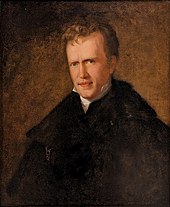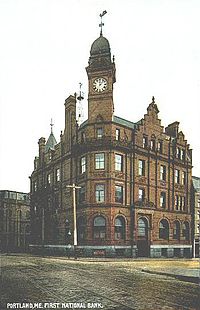History of Portland, Maine

The History of
Native Americans
There is evidence of Native American presence in what is now called Maine as early as 11,000 BCE. At the time of European contact in the sixteenth century,
A combination of warfare and disease decimated Native peoples in the years preceding English colonization, creating a "shatter zone" of devastation and political instability in what would become southern Maine. The introduction of European goods in the 1500s disrupted long-standing Native trade relationships in the northeast. Starting around 1607,
European settlement

The first
The next (and first permanent) settlement came in 1633 when
Raid on Portland (1676)
In 1676, the village was completely destroyed by the Abenaki people during King Philip's War. When English colonists returned in 1678, they erected Fort Loyal on India Street to ward off future attacks.
Battle of Falmouth (1690)

The village was again destroyed in 1690 during
American Revolution
On October 18, 1775, the community was destroyed yet again, bombarded for 9 hours during the Revolutionary War by the Royal Navy's HMS Canceaux under command of Lieutenant Henry Mowat.[13] The Burning of Falmouth left three-quarters of the town in ashes -- and its citizens committed to independence. When rebuilt, the community's center shifted from India Street to where the Old Port district is today. [14][15]
Trade and shipping center


Following the war, a section of Falmouth called The Neck developed as a commercial port and began to grow rapidly as a
In 1851,
The Cumberland and Oxford Canal extended waterborne commerce from Portland harbor to Sebago Lake and Long Lake in 1832. Portland became the primary ice-free winter seaport for Canadian exports upon completion of the Grand Trunk Railway to Montreal in 1853. The city's major passenger rail terminal, Union Station, was opened in 1888. In the 19th century, The Portland Company manufactured more than 600 steam locomotives. Portland became a 20th-century rail hub as five additional rail lines merged into Portland Terminal Company in 1911. Canadian export traffic was diverted from Portland to Halifax, Nova Scotia following nationalization of the Grand Trunk system in 1923; and 20th-century icebreakers later enabled ships to reach Montreal throughout the winter. [18]
In 1880, the Portland Longshoremans Benevolent Society was formed. A primarily Irish and Irish-American trade union, it organized between 400 and nearly 1,400 dockworkers for higher wages and went on short strikes in 1911 and 1913. Membership peaked in 1919 as a result of World War I and Europe's need for Canadian grain.
Regional cosmopolitan capital

Portland's period of greatest cosmopolitan prominence was in the first four decades of the nineteenth century, when the city was "a rival, and not a satellite of either Boston or New York."[19] In that period, Henry Wadsworth Longfellow got his start as a young poet and John Neal held a central position in leading American literature toward its great renaissance,[20][21] having founded Maine's first literary periodical, The Yankee, in 1828.[22] Other notable literary or artistic figures who got their start or were at their prime in that period include Grenville Mellen, Nathaniel Parker Willis, Seba Smith, Elizabeth Oakes Smith, Benjamin Paul Akers, Charles Codman, Franklin Simmons, John Rollin Tilton, and Harrison Bird Brown.
The Great Fire and rebuilding

The quality and style of architecture in Portland is in large part due to the succession of well-known 19th-century architects who worked in the city.
But by far the most influential and prolific architects of the West End area were
In 1895–1896, electric streetcars replaced horse-drawn carriages as the primary method of transportation into and around Portland. A week-long
Second World War
Casco Bay became
Decline and revival

The erection of the
But now the old seaport is attracting residents and investment. Because of the city government's emphasis on preservation, much of the opulent Victorian architecture of Portland's rebuilding has been restored. In 1982, the area was entered on the National Register of Historic Places. In modern lifestyle surveys, it is often cited as one of America's best small cities to live in.
Portland is currently experiencing a building boom, although more controlled and conservative than the 1980s building boom. In recent years, Congress Street has become home to more stores and eateries, spurred on by the expanding Maine College of Art and the conversion of office buildings to high-end condos. Rapid development is occurring in the historically industrial Bayside neighborhood, as well as the emerging harborside Ocean Gateway neighborhood at the base of Munjoy Hill.[29][30][31]
Since the mid-1990s,
Street namesakes
In 1995, a two-year study was completed, during which it was discovered that fifty of the city's 850 streets were named for particular subjects.[32] Allen Avenue is named for landowner Solomon Allen. Bramhall Street is named for George Bramhall, who owned a large tannery near the Western Promenade. Clark Street, meanwhile, is named for early settler Thaddeus Clark.[33]
Old postcards of Portland
-
Northeast from City Hall c. 1910
-
Monument Square c. 1908
-
State Street c. 1906
-
Western Promenade c. 1908
West End architecture
-
A house on Chadwick Street
-
A view down Carroll Street
-
A Vaughan Street residence
-
The West Mansion on the Western Promenade
See also
- Timeline of Portland, Maine, history
- Fort Gorges
- Fort Scammel
- Maine Historical Society & Museum
- McLellan-Sweat Mansion
- Munjoy Hill
- Portland City Hall
- Portland Museum of Art
- Portland Observatory
- Railroad history of Portland, Maine
- St. Lawrence and Atlantic Railroad
- Wadsworth-Longfellow House
- Victoria Mansion
- Portland Freedom Trail
- Abyssinian Meeting House
References
- ^ "Penobscot Dictionary entry". Penobscot Dictionary. the Penobscot Indian Nation, the University of Maine, and the American Philosophical Society. Retrieved 29 November 2023.
- ^ "Penobscot Dictionary Project". University Of Maine Library System. Retrieved 29 November 2023.
- ^ History of Portland, Maine, Maine Resource Guide, archived from the original on January 31, 2013
- ^ "The Almouchiquois". Falmouth Historical Society. Retrieved 29 November 2023.
- ^ Bruce J. Borque, Twelve Thousand Years: American Indians in Maine (Lincoln: University of Nebraska Press, 2002), 16; Emerson W. Baker, “Finding the Almouchiquois: Native American Families, Territories, and Land Sales in Southern Maine,” Ethnohistory 51, no. 1 (Winter 2004): 73-100; John Smith, A Description of New England (1616): An Online Electronic Text Edition, Paul Royster, ed., 36.
- ^ Christopher Levett, A Voyage into New England: Begun in 1623, and Ended in 1624 (London, 1628); Neal Salisbury, °Manitou and Providence: Indians, Europeans, and the Making of New England, 1500-1643 (New York, Oxford University Press, 1982), 50-84; David L. Ghere, "The 'Disappearance of the Abenaki in Western Maine: Political Organization and Ethnocentric Assumptions," American Indian Quarterly 17, no. 2 (Spring 1993): 193-207.
- ^ Christopher Levett, of York: The Pioneer Colonist in Casco Bay, James Baxter Phinney,1893
- ^ The Maine Reader: The Down East Experience from 1614 to the Present, Charles E. Shain, 1997
- ^ Christopher Levett: The First Owner of the Soil of Portland, Collections of the Maine Historical Society, 1893
- ^ Austin J. Coolidge & John B. Mansfield, A History and Description of New England; Boston, Massachusetts 1859
- ^ Joseph Conforti, "Creating Portland: History and Place in Northern New England;" Lebanon, New Hampshire 2005
- ^ p.431
- ^ Louis Arthur Norton, "Henry Mowat: Miscreant of the Maine Coast," 'Maine History, March 2007, Vol. 43 Issue 1, pp 1-20,
- ^ "Colin Woodard, Why the Royal Navy burned Portland in 1775; The Working Waterfront 2009". Archived from the original on 2008-10-12. Retrieved 2008-08-05.
- ^ James L. Nelson, "Burning Falmouth," MHQ: Quarterly Journal of Military History, Autumn 2009, Vol. 22 Issue 1, pp 62-69
- ^ Austin J. Coolidge & John B. Mansfield, A History and Description of New England; Boston, Massachusetts 1859
- ^ William Willis, History of Portland, Maine from 1632 to 1865; Bailey & Noyes, Portland, Maine 1865
- ^ William Willis, History of Portland, Maine from 1632 to 1865; Bailey & Noyes, Portland, Maine 1865
- ISBN 080-5-7723-08.
- ISBN 9781440854866.
- ISBN 080-5-7723-08.
- OCLC 7588473.
- ^ "George J. Varney, History of Portland, Maine; Boston, Massachusetts 1886". Archived from the original on July 9, 2012. Retrieved 2008-08-05.
- ^ William Willis, History of Portland, Maine from 1632 to 1865; Bailey & Noyes, Portland, Maine 1865
- ^ Babcock, Robert H. "Will You Walk? Yes, we'll Walk!: Popular Support for a Street Railway Strike in Portland, Maine." Labor History, vol. 35, no. 3, 1994, pp. 372-398.
- ^ Mooney, James L. Dictionary of American Naval Fighting Ships (1959-1981)
- ^ Morison, Samuel Eliot (1975). History of United States Naval Operations in World War II, Volume I The Battle of the Atlantic 1939-1943. Little, Brown and Company. p. 68.
- ^ "U.S.Navy Activities World War II by State". U.S. Naval Historical Center. Retrieved 2012-03-07.
- ^ "Bayside is a journey of many 'next steps'". Portland Press Herald (Blethen Maine Newspapers, Inc.). 2006-10-16. Archived from the original on 2006-10-22. Retrieved 2006-11-13.
- ^ Bouchard, Kelley (2006-10-06). "Riverwalk: Parking garage due to rise; luxury condos to follow". Portland Press Herald (Blethen Maine Newspapers, Inc.). Retrieved 2006-11-13.[permanent dead link]
- ^ Turkel, Tux (2007-02-06). "An urban vision rises in Bayside". Portland Press Herald (Blethen Maine Newspapers, Inc.). Archived from the original on 2007-12-26. Retrieved 2007-02-27.
- ^ Herald, Marketing DepartmentPortland Press (2015-12-02). "The word on the street (names)". Press Herald. Retrieved 2023-08-08.
- ^ The Origins of the Street Names of the City of Portland, Maine as of 1995 – Norm and Althea Green, Portland Public Library (1995)
Further reading
- Chen, Xiangming, ed. Confronting Urban Legacy: Rediscovering Hartford and New England's Forgotten Cities (2015) excerpt
- Michael C. Connolly. Seated by the Sea: The Maritime History of Portland, Maine, and Its Irish Longshoremen (University Press of Florida; 2010) 280 pages; Focuses on the years 1880 to 1923 in a study of how an influx of Irish immigrant workers transformed the city's waterfront.








